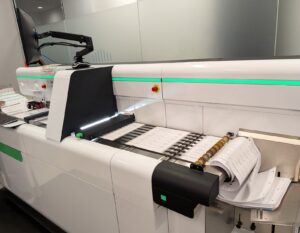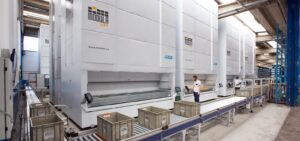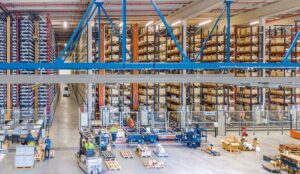In today’s logistics and supply chain landscape, sustainability is no longer an option—it’s a necessity. With over 30 years of experience, businesses are under increasing pressure to minimize environmental impact, optimize operations, and meet green regulations. One of the most effective ways to enhance warehouse sustainability is by implementing Vertical Storage Systems.
At Bradford Systems, we provide cutting-edge, leading, automated storage vertical storage solutions that streamline operations and reduce carbon footprints. From Vertical Lift Modules (VLMs) to Modula Vertical Storage and Vidir Vertical Lift Systems, our advanced storage solutions contribute to sustainable warehousing by optimizing space for raw materials, reducing energy consumption, and minimizing waste.
In this blog, we’ll explore how Vertical Storage Systems help businesses adopt eco-friendly warehousing practices while enhancing efficiency and profitability.
The Growing Need for Sustainable Warehousing
Warehousing and distribution centers account for a significant share of global carbon emissions. Excessive energy consumption, inefficient storage utilization, and outdated manual operations contribute to high carbon footprints.
Key sustainability challenges in traditional warehousing include:
- High energy consumption from HVAC systems and lighting in large facilities.
- Wasted space, leading to unnecessary expansion and resource usage.
- Excessive packaging and material waste due to inefficient inventory management.
- Longer material handling times, increasing fuel consumption in forklift and conveyor operations.
To combat these issues, companies are transitioning toward smart, automated, and vertical storage solutions that maximize efficiency while reducing environmental impact.
How Vertical Storage Systems Contribute to Sustainability
Optimizing Space Utilization & Reducing Warehouse Footprint
One of the most effective ways to cut down carbon emissions is by reducing the physical footprint of warehouses. Vertical Lift Modules (VLMs), Modula Vertical Storage, and Vidir Lift Systems allow businesses to store more in less space, significantly reducing land use and construction-related emissions.
Example: Modula Vertical Storage Solutions
Modula VLMs, including the Modula lift solutions, can reduce storage space by up to 90% by utilizing the warehouse’s vertical height, reclaiming valuable floor space. Instead of sprawling horizontal storage, goods are efficiently stored in an automated vertical column, allowing companies to:
- Minimize the need for expansion or additional warehousing.
- Lower heating, cooling, and lighting requirements.
- Reduce land-use-related emissions.
By reducing warehouse footprints, companies significantly lower energy consumption and carbon emissions, promoting sustainable operations.
Energy Efficiency & Reduced Power Consumption
Modern Vertical Lift Modules (VLMs) and Vertical Storage Systems integrate smart energy-saving technology, including:
- LED lighting with motion sensors to reduce unnecessary energy consumption.
- Automated systems that minimize power usage during idle times.
- Efficient motorized retrieval mechanisms that consume less electricity compared to traditional forklifts.
Example: Vidir Vertical Lift Systems
Vidir Vertical Lift Systems are designed with energy-efficient electric motors, reducing overall power consumption while improving material handling speeds. Their automated retrieval technology, controlled through the copilot console, further eliminates wasteful energy use associated with inefficient picking processes.
Reduction in Material Waste & Sustainable Inventory Management
Traditional storage methods often lead to damaged, lost, or expired inventory, contributing to excessive material waste. Vertical Storage Systems solve this issue by integrating smart inventory management software, ensuring:
- Better stock rotation, reducing expired or obsolete products.
- Minimized packaging waste, as materials are stored in organized, compact spaces.
- Optimized picking accuracy, reducing unnecessary material handling errors.
Example: Modula’s Smart Inventory Management
Modula’s automated inventory tracking system enables real-time stock monitoring, preventing overstocking and reducing waste due to misplaced or lost items, while ensuring seamless integration with your existing ERP for the best user experience. This results in lower disposal rates, which translates to a reduced carbon footprint and cost savings.
Reducing Emissions from Material Handling & Transportation
Forklifts and conveyors are commonly used in traditional warehouses, consuming vast amounts of fuel and electricity while generating harmful emissions. Vertical Storage Solutions significantly reduce reliance on these equipment by:
- Minimizing travel distances for pickers.
- Automating retrieval processes, cutting down manual transportation needs.
- Lowering forklift fuel consumption and battery waste.
Example: Vertical Lift Modules (VLMs)
Bradford Systems’ VLMs allow items to be retrieved at an ergonomic picking station, reducing the need for excessive forklift travel within warehouses. A factory-installed crane can also be used to lower fuel consumption, minimize wear and tear on transport equipment, and improve operational safety. Additionally, the inserter/extractor function enhances efficiency by optimizing storage space.
Compliance with Green Building Standards & LEED Certification
Many businesses aim to achieve LEED (Leadership in Energy and Environmental Design) certification for their warehouses. Vertical Storage Systems align with sustainable building requirements by:
- Optimizing space efficiency, reducing construction emissions.
- Lowering operational energy usage and meeting green energy standards.
- Minimizing material waste and enhancing warehouse sustainability.
By implementing Bradford Systems’ Vertical Storage Solutions, companies can achieve LEED certification faster and enhance their corporate social responsibility (CSR) initiatives.
Future of Eco-Friendly Warehousing with Vertical Storage
As industries prioritize sustainability, Vertical Storage Systems will be crucial in driving green warehousing. Future trends include:
- AI & IoT-enabled storage systems to further optimize inventory management.
- Integration with renewable energy sources, like solar-powered VLMs.
- Increased adoption of carbon-neutral and energy-efficient materials in storage design.
By adopting Bradford Systems’ Vertical Storage Solutions, businesses can future-proof their warehouses, lower operational costs, and contribute to a greener planet.
Make the Shift to Sustainable Warehousing
Sustainable warehousing is no longer an option—it’s necessary for companies looking to reduce their carbon footprint, cut costs, and improve efficiency.
Ready to transform your warehouse into a sustainable and efficient operation?
Contact Bradford Systems today to learn more about our eco-friendly Vertical Storage Solutions!
Are There Specific Industries That Benefit More From Vertical Storage Solutions?
Vertical storage helps businesses in many industries. It is especially useful for those handling small parts, accessories, or heavy items such as spare parts. Companies in manufacturing, automotive, e-commerce, and pharmaceuticals find vertical storage great for using space efficiently, even in limited ft areas, and fulfilling orders faster.
What Are Common Misconceptions About the Cost of Implementing Vertical Storage?
Many people wrongly believe that vertical storage solutions are very costly. In reality, they can save you a lot of money in the long run. This is because they save space, make work easier, cut down labor costs, and reduce mistakes. So, investing in vertical storage solutions can give you a good return on investment (ROI).






